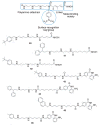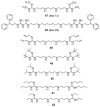Design of polyamine-based therapeutic agents: new targets and new directions
- PMID: 20095971
- PMCID: PMC3564240
- DOI: 10.1042/bse0460006
Design of polyamine-based therapeutic agents: new targets and new directions
Abstract
Enzymes in the biosynthetic and catabolic polyamine pathway have long been considered targets for drug development, and early drug discovery efforts in the polyamine area focused on the design and development of specific inhibitors of the biosynthetic pathway, or polyamine analogues that specifically bind DNA. More recently, it has become clear that the natural polyamines are involved in numerous known and unknown cellular processes, and disruption of polyamine functions at their effector sites can potentially produce beneficial therapeutic effects. As new targets for polyamine drug discovery continue to evolve, the rational design of polyamine analogues will result in more structurally diverse agents. In addition, the physical linkage of polyamine-like structures to putative drug molecules can have beneficial effects resulting from increases in DNA affinity and selective cellular uptake. The present chapter will summarize recent advances in the development of alkylpolyamine analogues as antitumour agents, and describe subsequent advances that have resulted from incorporating polyamine character into more diverse drug molecules. Specifically, new polyamine analogues, and the role of polyamine fragments in the design of antiparasitic agents, antitumour metal complexes, histone deacetylase inhibitors and lysine-specific demethylase 1 inhibitors, will be described.
Figures






References
-
- Casero RA, Woster PM. Terminally alkylated polyamine analogues as chemotherapeutic agents. J Med Chem. 2001;44:1–26. - PubMed
-
- Gerner EW, Meyskens FL., Jr Polyamines and cancer: old molecules, new understanding. Nat Rev Cancer. 2004;4:781–792. - PubMed
-
- Bey P, Danzin C, Van Dorsselaer V, Mamont P, Jung M, Tardif C. Analogues of ornithine as inhibitors of ornithine decarboxylase. New deductions concerning the topography of the enzyme’s active site. J Med Chem. 1978;21:50–55. - PubMed
-
- Mamont PS, Duchesne MC, Grove J, Bey P. Anti-proliferative properties of DL-α-difluoromethyl ornithine in cultured cells. A consequence of the irreversible inhibition of ornithine decarboxylase. Biochem Biophys Res Commun. 1978;81:58–66. - PubMed
-
- Levin VA, Hess KR, Choucair A, Flynn PJ, Jaeckle KA, Kyritsis AP, Yung WK, Prados MD, Bruner JM, Ictech S, et al. Phase III randomized study of postradiotherapy chemotherapy with combination α-difluoromethylornithine-PCV versus PCV for anaplastic gliomas. Clin Cancer Res. 2003;9:981–990. - PubMed
Publication types
MeSH terms
Substances
Grants and funding
LinkOut - more resources
Full Text Sources
Other Literature Sources
Research Materials

